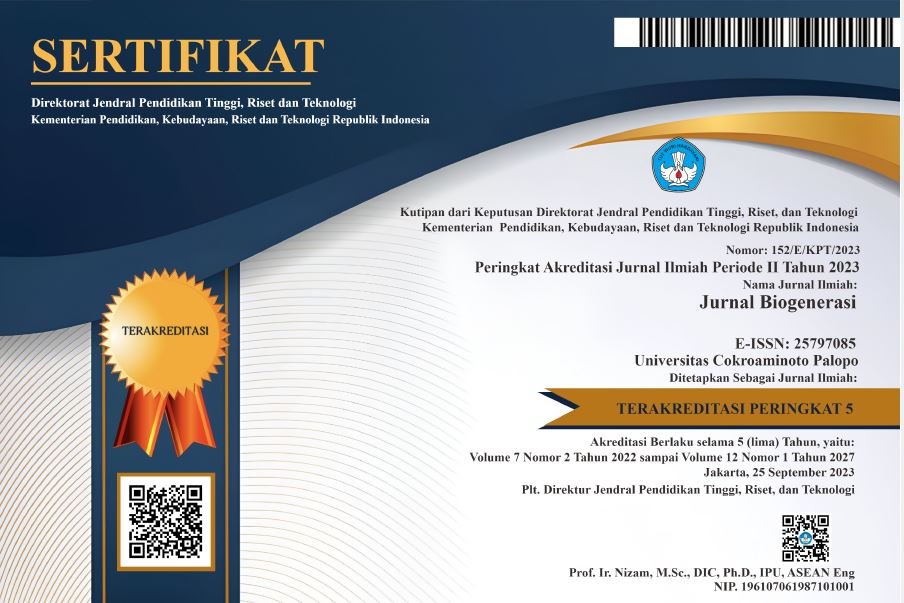EFEKTIVITAS CACING TANAH (Lumbricus rubellus) SEBAGAI AGEN BIOREMEDIASI TANAH TERCEMAR OLI MESIN DI KOTA MEDAN
DOI:
https://doi.org/10.30605/biogenerasi.v9i2.4758Keywords:
Soil Contamination, Engine Oil, Bioremediation, Earthworms, VermicompostAbstract
Soil contamination due to the disposal of used oil that has not been managed properly in automotive workshops has the potential to cause pollution and environmental damage. One alternative treatment that can be done is bioremediation using earthworms as bioremediation agents. This study aims to determine the effectiveness of earthworms in accelerating the recovery of soil contaminated with engine oil and the factors that influence the effectiveness of earthworms as bioremediation agents in soil contaminated with engine oil. The method used is an experiment with different treatment variations in each media. This study was conducted by mixing soil contaminated with engine oil, vermicompost, and earthworms. The test results showed that earthworms were able to reduce the levels of hydrocarbon compounds in the soil for 21 days of observation.accomplished with the aid of digital devices.
Downloads
References
Darmayanti, L., Putri, N. A., Muhardi, M. (2023). Pemanfaatan Vermicompost dan Cacing Tanah (Lumbricus Rubellus) untuk Bioremediasi Tanah Tercemar Minyak Bumi. Reka Buana : Jurnal Ilmiah Teknik Sipil dan Teknik Kimia, 8(1), 41-5
Dewi, S. R., & Sulastri, A. (2023). Bioremediasi Tanah Tercemar Limbah Oli Bekas Dengan Metode Composting. Envirotek: Jurnal Ilmiah Teknik Lingkungan, 15(2), 149-154.
Fitriani, D. A., Mahrup, M., Yasin, I., & Bakti, L. A. A. (2022). Kecendrungan Warna Tanah dan Status Bahan Organik Pada Lahan Pertanian yang Mengalami Penutupan Awan Rendah Berbasis Peta Terra Modis di Pulau Lombok. Journal of Soil Quality and Management, 1(1), 1-6.
Kartina, A. M., Nuniek, H., & Fatmawaty, A. A. (2016). Perbandingan sifat kimia dan kesuburan fisik tanah pada kondisi tempat tumbuh alami dan budidaya talas beneng (Xanthosoma undipes K. Koch) Di Kawasan Gunung Karang Kampung Juhut Kabupaten Pandeglang Provinsi Banten. Jurnal Agroekoteknologi, 8(1).
Khatimah, HK, Hernawati, H., & Rahmaniah, R. (2016). UJI KUALITAS FISIS PENGOLAHAN LIMBAH OLI BEKAS MENJADI BAHAN BAKAR ALTERNATIF DENGAN METODE DISTILASI SEDERHANA. JFT: Jurnal Fisika dan Terapannya , 3 , 41-50.
Melati, I. (2020). Teknik Bioremediasi: Keuntungan, Keterbatasan dan Prospek Riset. In Prosiding Seminar Nasional Biologi, Teknologi dan Kependidikan (Vol. 8, No. 1).
Pratama, S. F., & Handayani, D. (2017). Pengaruh Isolat Pseudomonas Sp. dan Bacillus sp. dengan Biostimulasi Kompos Jerami Padi (Oryza Sativa L.) Terhadap Penurunan Total Petroleum Hidrokarbon Tanah Tercemar Oli Bekas. Journal Biosains Volume 1 Nomor, 2, 322-328..
Saila, S., Rasyidah, R., & Mayasari, U. (2023). BIOREMEDIASI OLEH BIOKOMPOS PADA TANAH BENGKEL YANG TERCEMAR LIMBAH OLI BEKAS DI KOTA MEDAN. BEST Journal (Biology Education, Sains and Technology), 6(2), 871-877.
Saputra, R., Darmayanti, L., & Muhardi, M. (2022). Cacing Tanah (Lumbricus Rubellus) Sebagai Agen Bioremediasi Tanah Tercemar Minyak Bumi dengan Penambahan Vermikompos Sebagai Bulking Agent. Jurnal Daur Lingkungan, 5(2), 28-32.
Downloads
Published
How to Cite
Issue
Section
License
In submitting the manuscript to the journal, the authors certify that:
- They are authorized by their co-authors to enter into these arrangements.
- The work described has not been formally published before, except in the form of an abstract or as part of a published lecture, review, thesis, or overlay journal.
- That it is not under consideration for publication elsewhere,
- That its publication has been approved by all the author(s) and by the responsible authorities – tacitly or explicitly – of the institutes where the work has been carried out.
- They secure the right to reproduce any material that has already been published or copyrighted elsewhere.
- They agree to the following license and copyright agreement.
License and Copyright Agreement
Authors who publish with this journal agree to the following terms:
- Authors retain copyright and grant the journal right of first publication with the work simultaneously licensed under Creative Commons Attribution License (CC BY 4.0) that allows others to share the work with an acknowledgment of the work's authorship and initial publication in this journal.
- Authors are able to enter into separate, additional contractual arrangements for the non-exclusive distribution of the journal's published version of the work (e.g., post it to an institutional repository or publish it in a book), with an acknowledgment of its initial publication in this journal.
- Authors are permitted and encouraged to post their work online (e.g., in institutional repositories or on their website) prior to and during the submission process, as it can lead to productive exchanges, as well as earlier and greater citation of published work.


.png)

